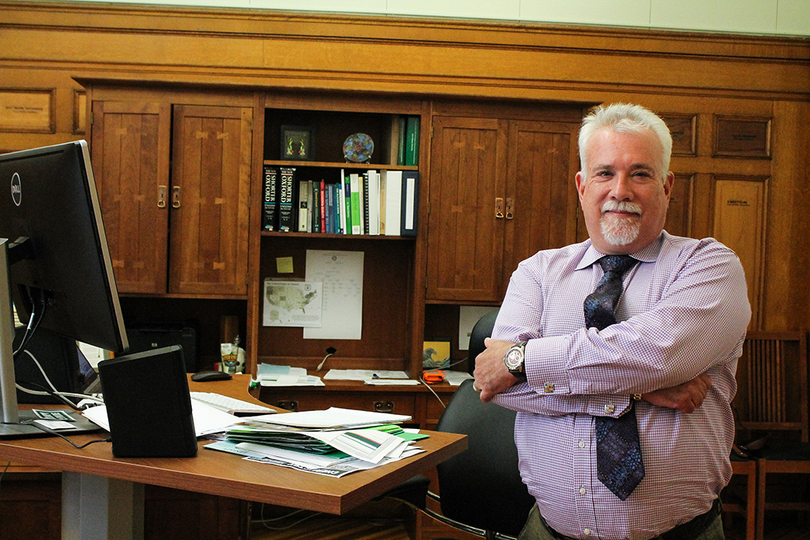SUNY-ESF interim president David Amberg wants to chart ‘financially viable’ path forward

David Amberg, SUNY-ESF’s new interim president, took over in July and will remain in the position for one to two years. Molly Gibbs | Photo Editor
For the first time in more than a decade, Colin Beier saw the door leading directly into the SUNY-ESF president’s office wide open.
“I’ve never seen that door open for more than a fleeting moment in the 11 years I’ve now been at ESF,” said Beier, a forest and natural resources management professor.
David Amberg, the office’s new occupant and SUNY-ESF’s new interim president, said he’s always worked with an open door policy. Setting a “tone of openness and accessibility” has been an essential part of his strategy since he took over as SUNY-ESF’s interim president in July, Amberg said.
Six months ago, former SUNY-ESF President Quentin Wheeler announced his resignation amid rising tensions between faculty and administrators and pressure from several campus organizations.
The college’s Academic Governance body voted no confidence in Wheeler in November 2016, citing what they called examples of poor leadership and a climate of fear in speaking out against his agenda. The vote didn’t affect Wheeler’s tenure, but it sent a signal about the campus community’s concerns to university stakeholders.
A bill of particulars released in February 2016 listed Wheeler’s failures with SUNY-ESF’s strategic plan, obtaining funding and managing financial resources and his relationship with the Board of Trustees.
And in January 2018, the administration’s controversial decision to remove three department chairs days before the start of the spring semester also contributed to tensions on campus. AG prepared to make a second vote of no confidence last March as the Graduate Student Association and the faculty union called for Wheeler’s contract to be terminated prior to his resignation.
After a tumultuous year, Amberg’s message to the campus community is clear: “The war is over.”
“Peace needs to be returned to the kingdom,” he said. “We need to resume to speaking to each other with respect, compassion and heart.”

Kevin Camelo | Digital Design Editor
Amberg came to SUNY-ESF after serving since 2014 as the vice president for research at the State Univeristy of New York Upstate Medical University, according to a release announcing his interim appointment. Amberg will remain in the interim position for one to two years, as the process for choosing the next permanent president gets underway.
But even though he’s stepped into the new job of leader, Amberg said he never anticipated being called to be president of a college.
“I’m very much a scientist,” he said.
Neal Abrams, chemistry professor and AG student life committee chair, said he first met Amberg during an AG meeting in late July. He described his style as “very approachable.”
“There is a notable shift in the interaction in a very, very positive way,” Abrams said. “He’s asking us questions, engaging us, trying to tackle some of the problems that we have and really looking for everyone to weigh in on good solutions.”
Abrams said that Amberg had a “positive view” on solving issues of classroom and research space “without having to be angry at one another or think that one person is trying to take over another person’s area.”
James Quinn, president of SUNY-ESF’s Undergraduate Student Association, said in mid-August that he’s primarily communicated with Amberg through email. He said he’s concerned with Amberg maintaining and promoting SUNY-ESF’s “spirit” with SU and other places around the world.

Laura Angle| Digital Design Editor
In 2003, SUNY-ESF created a strategic planning guide called Vision 2020 that listed seven goals, each with its own targets, for the college to achieve in the next two decades. The plan was updated in 2015 to bridge the college’s current needs and the original 2020 target date.
In his office on the second floor of Bray Hall, Amberg pointed to a large three-ring binder on the shelf above his desk. It held all the college’s strategic planning compiled during the last four years.
“The last several years have seen several rounds of strategic planning that didn’t
culminate in a plan that was implemented,” Amberg said. “But a huge amount of really great analysis and work was done.”
Now, at the request of SUNY Chancellor Kristina Johnson, SUNY-ESF will conduct another round of strategic planning that administrators are tentatively calling the “ESF Discovery Challenge,” Amberg said.
Under this plan, the college will examine previous strategic planning reports to identify three to five target areas that impact its research, education and outreach missions to undergo development and receive $200,000 a year from SUNY for three years, Amberg said. SUNY-ESF would also plan to fundraise around those target areas.
The concept of the ESF Discovery Challenge was modeled after a 2009 report called “Framework for the Future” done by Johnson while she was provost and senior vice president for academic affairs at Johns Hopkins University.
Amberg’s work over the next year or so will involve maintaining a connection to Syracuse University and finding a “financially viable” path forward that increases the quality of teaching and increases the impact of research to engage external stakeholders, he said.
“It’s going to take a little time,” Amberg said. “That past is never very far away.”






